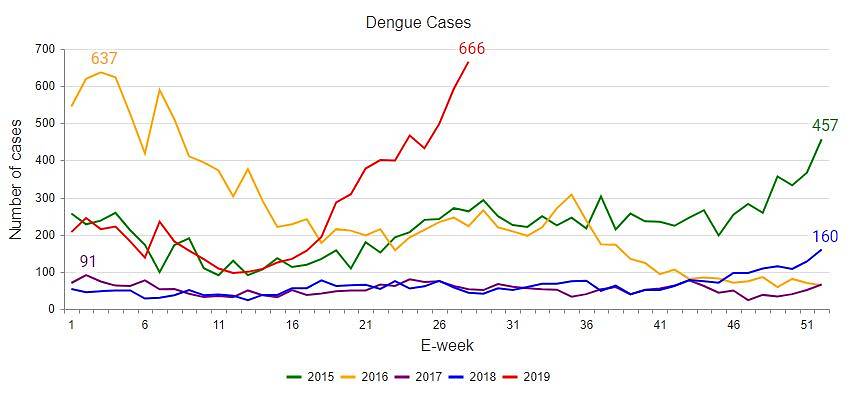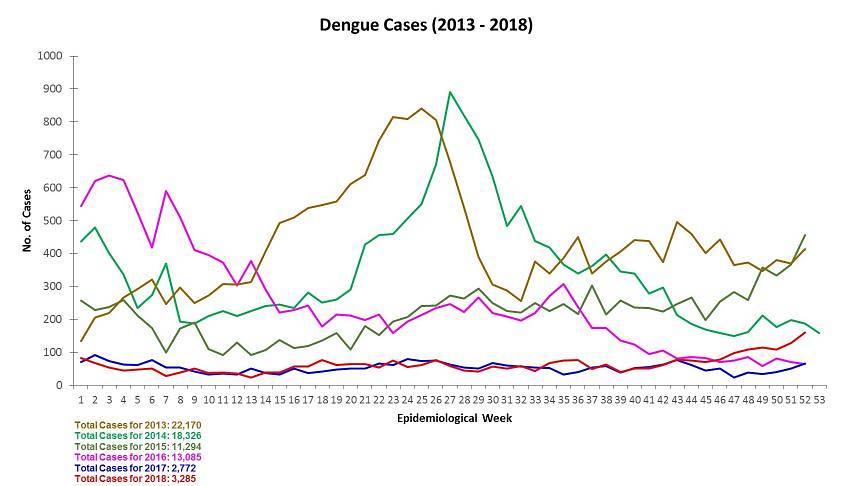SINGAPORE: Dengue cases last week rose to 666, the highest recorded in a week since 2016, the National Environment Agency (NEA) confirmed on Tuesday (Jul 16) on its website.
The last time the weekly recorded numbers peaked was in January 2016, when there were 637 cases in one week.
As of 3pm on Monday (Jul 15), there were 7,483 recorded cases of dengue in Singapore in 2019.
This is about five times more than the 1,481 dengue cases in the same period last year, NEA said. The number is also more than twice the 3,285 cases for the whole of 2018, and the 2,772 cases for all of 2017.

The weekly number of dengue cases in Singapore has hit a high since 2014. (Graph: NEA)
“Urgent action is needed to eliminate potential mosquito breeding habitats in the community,” the agency said.
Five people have died from dengue this year amid the spike in the number of cases.
Last month, an 84-year-old woman, who lived in an active dengue cluster at Lorong 6 Geylang, died from dengue. A 63-year-old man died of the disease in May.
In March, dengue claimed the life of a 71-year-old woman who lived in Ang Mo Kio, while two elderly men died in February.
“We are now in the warmer months of June to October, and a national collective effort is critical to prevent dengue cases from rising further,” NEA added.
“Every individual, whether living in a dengue cluster or not, needs to take action to prevent more people from being infected with the dengue virus.”

Number of dengue cases from 2013 to 2018. (Graph: NEA)
As of Jul 6, there have been 51 reported cases of dengue haemorrhagic fever – a severe form of dengue. That is more than three times the same number of cases – 16 – for the same period in 2018, according to figures from the Ministry of Health.
DENGUE CLUSTERS
As of Tuesday this week, there were 182 active dengue clusters, a spike from the 112 clusters about a month ago.
There are 48 high-risk areas with 10 or more cases, including neighbourhoods in Woodlands, Geylang, Chai Chee, Pasir Ris and Jurong East.
Parts of Joo Chiat, Bedok and Aljunied are also among the high-risk areas.
You can find the full list on NEA’s website.
Inspections by NEA showed that 60 per cent of all Aedes aegypti breeding habitats were in homes, Environment Minister Masagos Zulkifli wrote last Monday in a reply to a parliamentary question.
In dengue clusters, that proportion goes up to 74 per cent, he said, adding that homeowners played “a crucial role” in keeping dengue at bay.
“We have observed a slowing down in transmission of dengue in the last seven weeks at the Woodlands cluster, with one case reported in the cluster area in the past two weeks, compared to 27 cases reported in a week when transmission was at its peak,” NEA said.
“With the general uptrend in dengue cases across the island, large clusters with a relatively fast rate of dengue transmission have been observed at Pasir Ris, Joo Chiat and Jurong East. Everyone has to be alert to the threat of dengue.”
A worker fogs the drains in the common areas of a public housing estate in Singapore. (Photo: Reuters/Edgar Su)
To deprive mosquitos of their breeding habitats, people should invert pails and flower pot plates and change water in vases regularly. They should also clear their roof gutters and place insecticide inside.
NEA also advised people who are unwell to seek medical attention early if they show symptoms of dengue.
These include a sudden onset of fever for two to seven days, severe headache with pain behind the eyes, joint and muscle pain and a skin rash. Nausea, vomiting and bleeding from the nose and gums are also possible symptoms.





